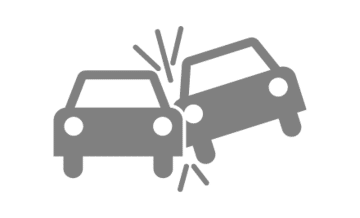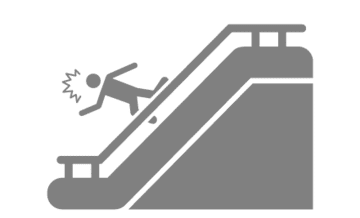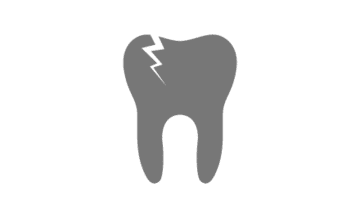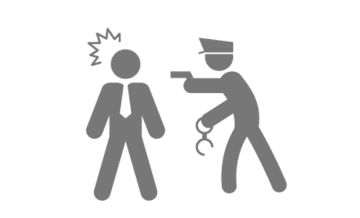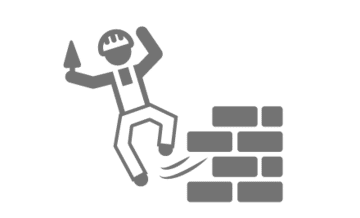Had a Trip and Fall Accident? Slip and Fall Accident or Other Premises Liability Claim?
Our Bronx premises liability attornies are ready to explain what you need to know if you were injured in a premises liability accident.
What is Premises Liability?
Premises liability is the area of the law that covers an owner’s obligation to keep property reasonably safe. These types of cases are handled by a premises liability lawyer. Under the law, owners have a duty to inspect, maintain and repair conditions on their property that are potentially dangerous.
In addition, there are many very specific legal requirements that an owner must follow to satisfy the law. For example, owners must inspect elevators and escalators at certain intervals; clear snow within a certain period of time; position and test smoke detectors in a clearly defined way; as well as many other very specific obligations. If you are injured because an owner has failed in any of these obligations, you may be entitled to file a claim.
 Want to Ask a Premises Liability Attorney If You Have A Premises Case? Click Here, Answer a Few Questions and Find Out.
Want to Ask a Premises Liability Attorney If You Have A Premises Case? Click Here, Answer a Few Questions and Find Out.
Trip and Fall Accidents
Trip and fall accidents are common occurrences that can lead to serious injuries. There are several causes of trip and fall accidents, including environmental hazards, uneven surfaces, poor lighting, and cluttered walkways. Environmental hazards like wet floors, loose rugs, or cracked/raised sidewalks can cause a person to slip or trip, leading to a fall. Uneven surfaces, like changes in elevation or damaged pavement, can also cause a person to lose their balance and fall.
Poor lighting can make it difficult to see obstacles or hazards, increasing the risk of a fall. Finally, cluttered walkways, such as debris or objects in a person’s path, can cause a trip and fall accident.
The physics of a trip and fall accident can be understood by examining the body’s center of gravity. When a person walks, their center of gravity is located in their torso, slightly above their hips. If an obstacle, like a raised edge or uneven surface, impedes the person’s foot, it can cause a change in the center of gravity, leading to a fall. When a person trips and fall, their body is subjected to a sudden deceleration, which can cause significant impact forces on the body, resulting in injuries like broken bones, cuts, and bruises.
Slip and Fall Accidents
Slip and fall accidents are a common cause of injuries, especially in public places like restaurants, shopping malls, and grocery stores. There are several causes of slip and fall accidents, including wet or slippery floors, icy or snowy sidewalks, loose mats or rugs, and poorly maintained flooring. Wet or slippery floors can be caused by spills, leaks, or condensation, while icy or snowy sidewalks can result from inclement weather conditions. Loose mats or rugs can cause a person to lose their footing, while poorly maintained flooring can have cracks, holes, or uneven surfaces, which can cause a person to trip and fall.
The physics of a slip and fall accident can be understood by examining the force’s action on a person’s body. When a person walks on a slippery surface, the friction between their shoes and the ground decreases, making it harder to maintain their balance. When a person slips, they can experience a sudden deceleration, leading to an impact force on the body, which can cause injuries like sprains, fractures, and head trauma.
Snow and Ice Accidents
Slip and fall accidents on snow and ice are a common cause of injuries during the winter months. The most common cause of these accidents are slippery sidewalks, parking lots, and driveways due to snow and ice accumulation. Other factors, such as improper footwear or walking too quickly, can also increase the risk of a slip and fall accident on snow and ice.
The physics of a slip and fall accident on snow and ice are similar to those of slip and fall accidents on any slippery surface. When a person walks on snow or ice, the friction between their shoes and the ground decreases, making it harder to maintain their balance. This results in a higher likelihood of slipping and falling. When a person slips and falls on snow and ice, they experience a sudden deceleration leading to an impact force on the body, which can cause injuries like sprains, fractures, and head trauma.
Elevator Accidents
Elevator accidents are rare, but they can cause serious injuries or even death. There are several causes of elevator accidents, including mechanical malfunctions, electrical failures, and user error. Mechanical malfunctions can occur due to improper maintenance or faulty equipment, such as an elevator door that fails to open or close properly. Electrical failures can cause sudden movements or stoppages, leading to injuries or entrapment. User error, such as overloading the elevator or attempting to pry open the doors, can also result in accidents.
The physics of an elevator accident can be complex, depending on the specific circumstances of the accident. In general, elevator accidents can be caused by sudden changes in acceleration or velocity, leading to impact forces on the body. For example, if an elevator suddenly stops or drops due to a malfunction, the occupants can experience a sudden deceleration, leading to an impact force on the body. Similarly, if the elevator doors close on a person, they can experience a force that can cause serious injuries.
Escalator Accidents
Escalator accidents are a rare but serious occurrences that can cause injuries or even death. There are several causes of escalator accidents, including mechanical malfunctions, user error, and improper maintenance. Mechanical malfunctions can occur due to faulty equipment, such as worn or missing steps or handrails. User error, such as not paying attention, wearing loose clothing, or using a stroller or wheelchair on the escalator, can also result in accidents. Improper maintenance, such as failure to inspect or repair the escalator, can increase the risk of accidents.
In general, escalator accidents can be caused by sudden changes in acceleration or velocity, leading to impact forces on the body. For example, if a step is missing or broken, it can cause a sudden jolt or impact when a person steps on it. Similarly, if a person’s clothing or body part gets caught in the escalator, it can cause a sudden pulling or twisting motion, leading to injuries.
Smoke and Fire Incidents
Preventable smoke and fire incidents can be caused by a variety of factors, many of which are the responsibility of the property owner. Common causes of preventable fires include improper storage of flammable materials, faulty wiring or electrical equipment, smoking indoors, and neglecting to properly maintain heating or cooking equipment. These factors can lead to fires that cause significant damage, injury, or loss of life.
A preventable fire can start when a source of heat, such as an open flame, comes into contact with a combustible material, such as paper, wood, or fabric. The heat from the source can cause the combustible material to reach its ignition point, which is the temperature at which it begins to burn. Once a fire starts, it can quickly spread and become difficult to control.
To prevent fires, property owners must take several steps, including properly storing flammable materials, regularly inspecting wiring and electrical equipment, banning smoking indoors, and properly maintaining heating and cooking equipment. They should also ensure that smoke alarms and fire extinguishers are installed and working properly. Additionally, its important for property owners to have an emergency plan in place in case of a fire, including evacuation procedures and communication with local fire departments.
Inadequate Security Incidents
Property owners have a legal responsibility to provide adequate security for their premises to protect visitors, tenants, and employees from harm. This responsibility includes taking reasonable measures to prevent criminal activity, such as installing and maintaining appropriate lighting, alarms, surveillance cameras, and locks on doors and windows.
If a property owner fails to provide adequate security, they may be held liable for injuries that occur on their premises. For example, if a visitor is assaulted or robbed due to a lack of security, the property owner may be held responsible for any resulting injuries or damages. Additionally, if a tenant is injured due to a broken door lock that the property owner failed to repair, the property owner may also be held responsible for any resulting injuries.
To avoid legal liability, property owners must take reasonable steps to ensure the safety of their premises. This includes regular inspections of the property to identify potential security risks, such as broken locks or fault alarms, and addressing those risks in a timely manner. Property owners should also train employees and security personnel to identify and respond to potential security threats.
Dog Bites
Owners of dogs can be legally responsible if their dog bites someone. A dog’s bite can cause serious injuries and can lead to legal liability for the owner. In most cases, the owner’s responsibility depends on the dog’s known history of aggressive behavior. As a result, a dog’s history of biting, or aggressive behavior in the past, is extremely important in this type of case.
How Do I Prove (and Win) a Premises Liability Case?
To win a premises liability case, you must show that you were injured because the premises were not reasonably safe. In addition, you must demonstrate that the owner was, or should have been, aware of the dangerous condition before the accident and did have a “reasonable” opportunity to fix the problem before you were hurt. This requirement, known as the notice requirement, gives rise to much of the litigation in this area of the law. This is true because your case will be dismissed if you cannot prove notice.
To prove notice in a premises liability case, you must consult an experienced premises liability attorney who can investigate the case thoroughly and do the needful.
What is Notice and Why Is It Important in a Premises Liability Case?
Legal notice is a critical element of proving a premises liability case. Notice refers to the property owner’s knowledge or awareness of a potential hazard on their premises, such as a slippery floor or broken stairs. To establish liability, the injured party must prove that the property owner noticed the hazard prior to the accident, and failed to take appropriate action to fix it.
There are two types of notice: actual notice and constructive notice. Actual notice is when the property owner is personally aware of the hazard, either because they saw it themselves or someone reported it to them. For example, if a customer in a store spills a drink on the floor and tells a store employee, the store now has actual notice of the hazard.
Constructive notice, on the other hand, is when the property owner should have been aware of the hazard through reasonable inspection and maintenance procedures. For example, if a stair railing is loose and the property owner failed to notice it during a routine inspection, they may be considered to have constructive notice of the hazard.
To prove notice in a premises liability case, it is important to gather evidence such as witness statements, maintenance records, and inspection reports, to establish when the property owner knew or should have known about the hazard that caused the injury.
What is Prior Written Notice, and When Is It Necessary?
Prior written notice is a legal concept that applies to municipal defendants, such as the City of New York, in premises liability cases. Under New York law, municipal defendants are generally immune from liability for injuries caused by defective sidewalks or other public property unless the plaintiff can show that the municipality had prior written notice of the defect and failed to take appropriate action.
In cases against municipal defendants, the injured party or their attorney must file a Notice of Claim with the municipality within 90 days of the injury causing incident. The notice of claim must include the date, time and location of the incident, a description of the injuries sustained, and a detailed description of the defect or hazard that caused the injury. If a plaintiff fails to file a notice of claim within the 90-day period, the lawsuit against the municipality may be legally barred.
It is important to note that the prior written notice requirement only applies to municipal defendants and not private property owners. It should also be noted that claims against municipal defendants usually have shorter statutes of limitations.
Premises Liability Attorny – Lawyers24-7.com | Ask Questions – Get Answers
If you have any questions about premises liability, contact our experienced premises liability attorneys by email or by calling (800) 762-9300 for a free consultation. You can also simply fill out one of our case intake forms and we will have one of our attorneys get right back to you.
You Might Also Be Interested In:

